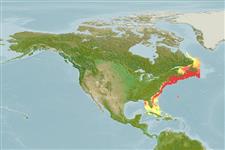Malacostraca |
Decapoda |
Cancridae
Environment: milieu / climate zone / تغييرات عمق / distribution range
بوم شناسي
; تغييرات عمق 0 - 800 m (مرجع 367). Subtropical, preferred 11°C (مرجع 107945); 59°N - 20°N, 85°W - 52°W
Western Atlantic: from Newfoundland and Labrador, Canada to Dry Tortugas, Florida and Cuba.
Length at first maturity / Size / Weight / سن
بلوغ: Lm 8.8 range ? - ? cm Max length : 16.0 cm CW جنس نر / بدون خواص جنسي; (مرجع 101412); بيشينه وزن گزارش شده: 0.00 g
Carapace approximately 2/3 as long as wide, surface coarsely granulate; front (excluding inner orbital angles) with 3 teeth, middle one exceeding others and depressed (flattened dorsoventrally); anterolateral margins divided into 9 quadrangular lobes or teeth with margins minutely denticulate; notches between teeth continued on carapace as short, closed fissures. Pincers stout, nearly as long as second legs, carpus and hand with strong granulose rugae, upper margin of pincers denticulate, carpus with sharp inner dorsal spine. Color: red dorsally, yellow ventrally; back with 2 curved lines of yellowish spots and behind middle, a figure somewhat resembling letter H; legs mottled and reticulated with yellow and red, more or less purplish.
Minimum depth from Ref. 97531. Lives in deep water (Ref. 106868). Occurs from the intertidal zone among rocks to 800 m (Ref. 367). Common in shallow subtidal zone during summer (Ref. 106868). Small to medium-sized individuals are found near shore seasonally (especially in the south), while larger ones only occur in deeper water (Ref. 367). Moves from subtidal into low intertidal with the tide (Ref. 106868). Found in rocky bottom in association with Homarus americanus. Also on rubble and soft substrate (Ref. 97531). Feeds mainly on mollusks, echinoderms, and other invertebrates (Ref. 367). Preyed upon by gulls (Ref. 106868).
Life cycle and mating behavior
بلوغ | تولید مثل | تخم ریزی | Eggs | Fecundity | Larvae
Members of the order Decapoda are mostly gonochoric. Mating behavior: Precopulatory courtship ritual is common (through olfactory and tactile cues); usually indirect sperm transfer.
مآخذ اصلی
مراجع | هماهنگ كننده | همكاران
Tavares, M. 2003 True Crabs. pp. 327-352. In Carpenter, K.E. (ed.) The living marine resources of the Western Central Atlantic. Volume1: introdution, molluscs, crustaceans, hagfishes, sharks, batoid fishes, and chimaeras. FAO Species Identification Guide for Fishery Purposes and American Society of Ichthyologists and Herpetologists Special PublicationNo. 5. Rome, FAO. pp. 1-600. (مرجع 367)
وضعيت در فهرست قرمز IUCN
(مرجع 130435: Version 2025-1)
وضعيت از نظر سايتس (مرجع 108899)
Not Evaluated
Not Evaluated
خطر برای انسان ها
استفاده انسانی
ماهي گيري – شيلات: تجاري
FAO - ماهي گيري – شيلات: landings | FishSource | Sea Around Us
ابزارها
اطلاعات بيشتر
PhysiologyOxygen consumption
Human RelatedStamps, coins, misc.
منابع اينترنتي
Estimates based on models
Preferred temperature
(Ref.
115969): 1.6 - 17.9, mean 6.4 (based on 149 cells).
Fishing Vulnerability
Low vulnerability (10 of 100).
Climate Vulnerability
Low to moderate vulnerability (30 of 100).
Nutrients : Calcium = 109 [35, 184] mg/100g; Iron = 1.59 [1.21, 1.97] mg/100g; Protein = 20.2 [19.2, 21.3] %; Omega3 = 0.285 [0.185, 0.386] g/100g; Selenium = 48.3 [-31.7, 128.3] μg/100g; VitaminA = 0 μg/100g; Zinc = 1.79 [1.17, 2.40] mg/100g (wet weight); based on
nutrient studies.
